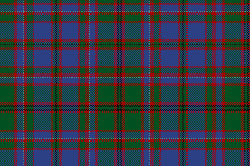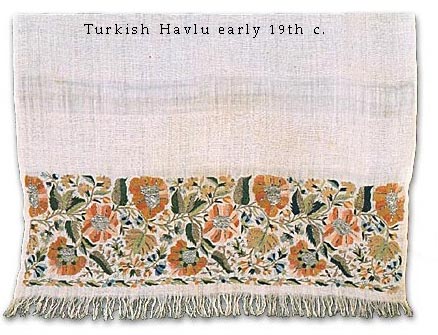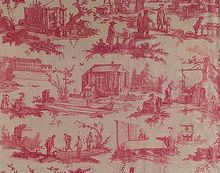Tabby. Same as plain weave (taffeta or muslin). Warp and filling alternate. Also called J-f weave.
Table felt or padding. See Silence cloth.
Taffeta (from the Persian word, "taftah"—to spin).
1. Plain, closely woven, smooth silk fabric, the warp and filling of the same or nearly the same count. May have a small figure introduced on plain background. Skein, piece-dyed or printed. Tends to split if heavily weighted. Chiffon taffeta, soft and light weight. Uses: dresses, trimmings, millinery, hangings. Weave—plain. Width, 36", 40".
2. Fine, smooth, closely woven, light-weight wool fabric, much lighter and finer than Panama. Similar to nun's veiling, but has a smoother surface and harder twisted yarns. Like wool batiste, only closer and stronger. Washes and wears well. Plain color or light stripes. Often made with cotton warp and fine wool filling. Uses: men's shirts, women's and children's dresses. Weave—plain. Width, 40", 52".
Tapa cloth. Bark cloth, made without spinning or weaving, from inner bark of certain tropical trees in the South Sea islands. Valued for excellent printed designs, applied by primitive means.
Tapestry. Originally a hand woven fabric made with a bobbin worked from the wrong side on a warp stretched vertically or horizontally. The bobbin is carried only to the edge of the pattern and not from selvage to selvage. The Gobelin tapestries in France are most famous; used for wall hangings in cathedrals and palaces. The same methods are used in making tapestries to-day. Original designs are employed and historic patterns are reproduced.
A machine reproduction of tapestry is a yarn-dyed, figured fabric composed of two sets of warp and filling yarns woven on a Jacquard loom. Power loom drapery fabrics imitate real or bobbin tapestries. The wrong side is smoother than in a hand-woven tapestry. Wool, cotton, silk, rayon, and mixtures. Use: upholstery and wall hangings. Weave— Jacquard. Width, 50". Tapestry Brussels. Kind of carpet imitating body Brussels.
Yarn for pile printed, before weaving, to make design.
Tarlatan. Thin, very open cotton fabric highly sized. About as coarse as thin cheesecloth, only very wiry and transparent. White or colors. Will not launder. Uses: pageant costumes, doll dresses, Christmas stockings, bed canopies instead of mosquito netting, millinery pvirposes. Weave— plain. Width, 54", 60".
Tartan. Originally Scotch plaids in woolens or worsted with distinctive designs and colors for each Highland clan. Now, plaid wool or wool and cotton goods.

Teasel. A prickly bur used in woolen cloth manufacture for raising nap. Nap is raised on lower priced fabrics by use of fine wire brushes.
Tentering. A finishing process. Cloth is attached by the selvage on tenter hooks in a frame where it is stretched the desired width and dried. Small holes in selvage sometimes show marks of hooks.
Terry. Cotton fabric covered with loops on both sides. It
requires two sets of warp and one of filling. One set of warp
is held taut while weaving, the other set is released to form
loops,
1.. When woven in linen (rare) or bleached cotton
in narrow widths, it is called Turkish toweling. Made in
checks, stripes or plaids for bathrobes and slippers. Good
Turkish towels have two loops (called double loop terry).
A poorer quality with less absorbing surface has single
loops on surface. Fancy towels made of mercerized yarns
with colored Jacquard borders have least absorbing power.
Mercerized loops are single and far apart. Wash cloths,
which imitate terry, have loops fastened in the knitted fab
ric which pull out like a chain stitch when a yarn breaks.
Turkish towels are often woven towel length and hemmed.

Weave—looped pile. Width, 18", 20", 22", 24".
2. Drapery
fabric is dyed or printed; reversible; rich texture; tends
to hold dust and to fade. Uses: hangings, pillows. Weave
—looped pile. Width, 36", go". :
Texture. The surface effect of cloth.
Tezzo*. Sec Silk and Cotton Fabrics.
Theatrical gauze. Loose, open, linen fabric, more transparent than scrim. Originally for background of stage scenery, Desirable for window curtains because of transparency and beautiful texture. Natural linen color, yarn-dyed or striped. Uses: theatrical scenery, window curtains. Weave—plain. Width, 36", 72".
Thread. Made of cotton, silk or linen for sewing purposes or lace making. Contains three or more hard spun yarns twisted. Soft or glazed finish.
Thread and Thrum.* Trade name for a plain woven rug (plain color with striped borders). Cotton warp, worsted weft; reversible, in all sizes.
Thread silk. Pure silk yarn for woven or knitted goods. Not weighted. Means reeled, not spun.
Three-quarter goods. Measuring twenty-seven inches wide.
Ticking. Strong twilled cotton fabric with yarn-dyed stripes lengthwise in blue, red, brown, etc. on white. Similar to denim in texture; often herringbone twill in stripes; should be light in weight and feather proof. Uses: pillows, mattresses. Weave—twill. "Width, 27", 30", 36", usually 30". See Art Ticking.
Tied and dyed. Hand method of producing patterns on cloth. Tied portions which resist the dye make the design. Imitated in machine printing.
Tinsel. Synthetic metal filament wound around cotton yarn used in metal cloth and metallic silk brocades. Imitates strips of gold and silver used in historic brocades and " cloth of gold."
Tire fabric. Firm cotton cloth to be vulcanized for automobile tires. Plain, fancy weave and "cord" fabric (heavy warp and light weight filling which disappears in vulcanizing).
Tissue. ("Tissu" Fr. for fabric.) Any light weight open fabric. Usually refers to tissue gingham. See Gingham.
Toile (pr. twal). General French term for cloth.
Toile de Jouy. Modern reproductions of famous French prints of the 18th century. Typical designs are landscapes and figure groups in monotone of brick red, blue or other colors on a white or light background. Widths, 30", 36", 45", 5o".

Top. The longer wool fibres which are separated from the short ones (noils) by combing. Used for worsted yarns.
Tow. The shorter flax fibres separated by combing from the longer fibres (line).
Toweling. A term which covers the following fabrics: Crash, birdseye, damask, glass, honeycomb, huck, twill, Turkish and fancy weaves. See these terms. Toweling is often woven in linen with a stripe of cotton near the selvage.
Such a towel could not be sold for all linen; yet, its usefulness is not lessened by the small amount of cotton, which lowers the manufacturing cost. Towels are often made for hotels or institutions with the name woven in a colored band or in white. Unbleached towels are less expensive than bleached and should wear longer. Cotton and union towels are harder to launder, they do not let go of the dirt easily and are more difficult to keep white than linen.
Durability depends upon the quality of yarns and weave. A cotton huck may outwear an all-linen crash towel. If linen yarns are made of short fibres and loosely woven or weakened by chemical bleaching, the fabric will not give good service.
Tricolette (pr. tree-co-let). Fabric knitted from rayon. Plain or novelty effects in knitting. Trico Sham* is similar to tricolette but of finer gauge. Width, 36" and 54".
Tricot (pr. tree-co, French "tricoter", to knit). Old name for Jersey cloth. Modern warp knit silk fabric. On the right side it appears like rib knitting and on the wrong side the ribs run cross-wise. Tends to shrink lengthwise. Not sold by the yard. Tricot for glove silk underwear is made in 3 grades or weights. Uses: underwear; cotton tricot is used for brassiers and girdles. Width, 14 ft. Tricotine. Worsted dress goods, resembling gabardine, but woven with a double twill. Wears well but grows shiny. Very fine tricotine appears to be knitted. Uses: suits and dresses. Weave—twill. Width, 54".
Tubing. Cotton or linen fabric, woven in tube form for pillow cases. Weave—plain. Width, 40", 42", 45".
Tub silk. See Wash silk.
TUCKS: A tuck fabric is a single cloth and is made by using two or more warps.
Tulle. General term meaning a fine silk net. Similar to maline, with softer finish. Adapted to draping while maline makes stiff frills and bows on millinery or dress trimmings. Use: chiefly for wedding veils, also for party gowns. Weave— net. Width, 36", 72", 108".
Turkey red. Fast red on cotton made from vegetable madder or modern synthetic madder. Plain red calico dyed in this way, called Turkey red. Madder dye originally brought from Turkey.
Turkish toweling. See Terry.
Tussah. See Pongee.
Tweed. Originally an all wool home-spun made in Scotland. Rough, coarse cloth made from worsted yarns containing wiry and heavy wools. Stock-or yarn-dyed. Very durable. Uses: coats and suitings, suitable for sports wear. Weave— plain, twill or herringbone twill. Typical designs are Gun Club (a large check over a small one) and Glen Check (similar to shepherd's check but in a variety of color combinations). Width, 54".
Twill. A fundamental weave admitting of many variations. Found in serge, denim, Canton flannel. Intersection of yarns form lines running to the right or left diagonally across the fabric.
PREVIOUS-----NEXT



